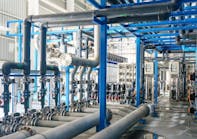Excessive levels of iron and manganese are very common water problems in many U.S. homes. Unlike certain health related contaminants that are typically unseen, these contaminants exhibit undesirable visual and aesthetic properties such as color, odor and poor taste. In public water systems, they can react to form products that cause significant issues such as plugging of piping, distribution lines and home plumbing networks. There are several different ways water treatment professionals can solve these issues. Here”s a look into how these problems can be solved.
Ways to treat iron and manganese
Although multiple options for iron removal are in use, most fall within one of the following three categories:
- Sequestration
- Cation exchange
- Oxidation/filtration (e.g., specialty filtration media types).
Where iron is very low (typically 0.3-0.8 mg/L), sequestering agents, which use some form of polyphosphates to combine with the dissolved ferrous iron, can effectively keep the iron in solution by combining with the iron to form a protective coating, preventing it from forming filterable precipitants and depositing. However, it must be noted that iron is not removed, but complexes with the sequesterent. Although they can be effective, sequestering agents are not usually practical or efficacious for high flows or systems with iron concentrations over a certain threshold.
Cation exchange, using conventional softening resins, can be effective for reducing low levels of dissolved iron. In addition to calcium and magnesium, ferrous iron as Fe+2 is exchanged for sodium on the resin and regenerated with salt brine regularly depending on the hardness of the water. Most water treatment professionals would agree that softening for iron and manganese removal can be efficacious (if the elements are in the dissolved state), but for iron removal alone it is not the most practical solution for high flows or concentrations of iron and manganese exceeding 0.8 mg/L or 0.1 mg/L respectively.
This is primarily due to the degradation of the resins over time and more frequent regenerations and higher brine use. Also, regeneration effectiveness and frequency needs to be monitored closely. One other drawback is that if the constituent is oxidized prior to reaching the softener it can result in fouling, a high drop in pressure, and subsequent bleed through.
The majority of iron filtration systems operate on the principle of oxidizing the dissolved Fe+2 iron to convert it to the Fe+3 state to produce a filterable particle. Once in the ferric state, iron can be filtered with a number of different filtration media under the right conditions. Effective oxidants used to help facilitate this conversion include chlorine, chlorine dioxide, permanganate and ozone.
Aeration has also been used for years in both small and large water systems, but the kinetics of iron conversion are relatively slow compared to chemical oxidants and require more time, contact vessels or other ancillary equipment for effective iron removal. The pH of the water is another often overlooked factor in iron removal. The pH should be above 6.8 and preferably in the range of 7.5 to 8.5 for optimal removal.
Oxidation/filtration technology utilizes either an oxidant (as described above) plus conventional or specialty media to oxidize and filter iron from water. Systems are used in conventional pressure vessels with the oxidant being injected upstream of the process. The filter medias that are commonly used are:
- High content Manganese Dioxide Minerals (e.g., AD26, pyrolusite)
- Anthracite/sand combination or silica base with manganese dioxide coating
- Glauconite, a zeolite mineral coated with manganese (i.e., greensand)
- Maganese coated or fused silica (i.e., greensand plus)
- Other specialty medias.
Determining the ferrous and/or ferric form of iron
In groundwater systems, iron occurs in one of two oxidation states: Reduced soluble divalent ferrous iron (Fe+2) or oxidized insoluble trivalent ferric iron (Fe+3). Ferric hydroxide (Fe(OH)3) is the direct result of ferrous iron oxidation and precipitation. The ferrous form is often associated with bicarbonates and is therefore colorless or referred to as “clear” iron. The oxidized form or (Fe(OH)3) is a precipitant and oftentimes a filterable particulate; therefore, there are different methods to measure them in the field or laboratory.
Determining the manganous or manganic form of manganese
Manganese exhibits multiple valence states. One of the more important ones for water treatment is the manganese in the +2 oxidation (Mn II) state as an ion in solution. This form, when oxidized in water systems, forms manganic dioxide, which is responsible for the poor aesthetic quality of water giving it the brown or blackish color and other undesirable effects such as piping deposits in the distribution systems. To address this, manganese (II) can be oxidized to insoluble manganic dioxide (MnO2) and removed subsequently by a clarification or filtration process. Oxidation to this more insoluble form can be achieved by a combination of the right water quality conditions using aeration, chlorine, chlorine dioxide, permanganate or others.
Once those factors are established, what is the best way to reduce them? Among the most common methods is oxidation and filtration using one of the oxidants listed in combination with a specialty media for filtration. One of the recent enhancements for iron and manganese removal has been the use of solid phase manganese dioxide media for oxidation/filtration. High manganese chloride type medias such as the AD26 and others are examples of a catalytically active MnO2 media for iron and manganese removal. This media is high (> 75 percent by weight) content MnO2 mineral, which has a successful history of use for iron and manganese removal and carries an NSF 61 Certification for drinking water use.
Medias such as this are deployed in typical pressure filtration systems with carbon steel vessels with internal distribution headers, collection laterals and automated control valves and piping. Chlorine, most often in the form of sodium hypochlorite (12.5 percent), is used to precede the media beds.
Unlike conventional iron/manganese removal, the chlorine injection occurs just before entering the filtration vessels, requiring only a very short contact time. These conditions facilitate a very rapid oxidation on the surface of the media to facilitate the oxidation/filtration process in a single step with no long residence times or contactor required.
Advantages are numerous, including:
- Higher filtration rates (6-12 gpm/sq. ft.) compared to conventional 3 gpm/sq. ft. filtration approaches; this equates to service rates of three times that of conventional technology
- Very short contact time for chlorine of 15-30 seconds versus minutes of time normally required
- Smaller treatment vessels that occupy much less footprint
- No addition of potassium permanganate needed
- Does not need dissolved oxygen or require aeration to facilitate removal
- Excellent co-contaminant removal of iron, manganese, arsenic and hydrogen sulfide.
- Long media life exceeding 10-15 years
- Iron and manganese removal efficiencies of 90-99 percent can be achieved reliably.
There are many factors that go into determining the type of iron and manganese problem your customer has, but the good thing is that there are ways to prevent them from happening and there are ways to treat them once the problem occurs. Solving the problem begins with an understandting of the water chemistry, obtaining an analysis of the home”s water is a vital part to assesing the problem and sorting out the treatment options and the best path for prevention.
Greg Gilles is vice president and principal for AdEdge Water Technologies, LLC. He has over 25 years of treatment technology, industrial, regulatory, engineering and management experience. He holds an M.S. degree in environmental science/engineering and a bachelor”s degree in biology/chemistry from Indiana University. He can be reached at 678-835-0052 or email: [email protected].


